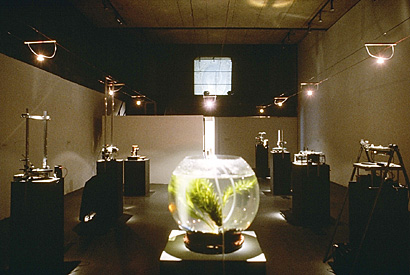
Paul DeMarinis’ The Edison Effect (1989-93) is a “series of sound sculptures that play antique Edison cylinder recordings with laser beams. The reflections of light from the walls of the cylinder’s grooves carry the audio information to a converter where it is translated into an electrical signal, then into music by a loudspeaker. First, however, in the element ‘Al and Mary Do the Waltz,’ the beam passes through a bowl containing two live goldfish, whose movements can interrupt the flow of information and the resulting sound. When not blocked by the fish, the resultant sounds range from recognizable to distorted, something like a distant shortwave radio or a haunting bit of a melody teleporting from the past. ‘The arrangement of optics, motors and light allow random access to the grooves of the records, permitting distortion, dis-arrangement and de-composition of the musical material,’ DeMarinis comments. One of many interpretations of the title is the drastic change in music that followed Edison’s invention of sound recording. It also refers to the discovery of thermionic emission (atoms from a glowing filament that cause the inside of a light bulb to darken), which led to the development of vacuum tubes and sound amplification. The work combines ancient and modern technologies, electronics and sound. The latter is a common combination in many of DeMarinis’s works: Music as a Second Language is a compact disc of speech processed by computers, and Grey Matter creates music through the communication of body and electricity.”[1]
“The installation ensemble … connects the Ages of Mechanical, Electronic, and Digital Audio-Technologies. Different interactive systems probe the acoustic inscriptions of vinyl discs, and other objects, with the help of laser beams (which officially serve CD technology). DeMarinis also assigns to them, in part, the sounds of other audio devices. Along these lines, DeMarinis combines in «March» the vinyl disc recording of a military march by John Philipp Sousa with the typical, techno-instrument, TR-808, an electronic rhythm-producing machine. «Etaion Shrdlu» makes it possible to hear how an Edison phonograph inevitably inscribes the sounds of its own machinery into the waltz. Two «Fragments from Jericho» masquerade as thousand-year-old finds of sound cylinders and release unexpected sounds from archaic times. Removed from their customary functionality, the technologies applied in the works of DeMarinis reveal a hidden, mystical character.” [2]
See also, Paul DeMarinis, “Essay in lieu of a Sonata – Reflections on ‘The Edison Effect’ – a series of audio installations consisting of electro-optical devices which play ancient phonograph records with laser beams.” https://people.well.com/user/demarini/edison.html
The Edison Effect (1993) from Paul DeMarinis on Vimeo.
[1] Edward A. Shanken, Art and Electronic Media, 2009, p 73.
[2] http://www.medienkunstnetz.de/works/the-edison-effect/video/1/
